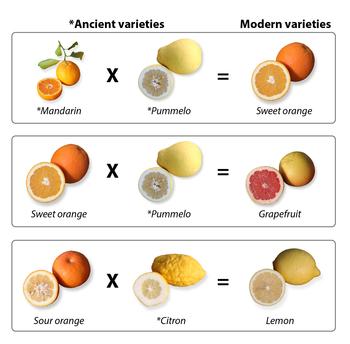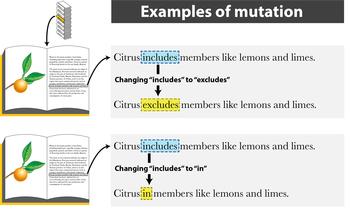New genome editing technologies - CRISPR

Revised December 20, 2018.
What are older genetic modification techniques?
Our ancestors had no idea that the genetic information in a cell, its DNA, is passed down from one generation to the next, and is responsible for the way plants look, taste, and how much food they produce. But they figured out that through a process, called selective breeding, they could breed two plants with different, valuable traits, like high yield and disease resistance, to create offspring with both of these valued traits. Over time, changes from the breeding process resulted in dramatic changes in the plant’s DNA and consequently, in the way the citrus family looks and tastes. For example, mandarin and pummelo crosses created the sweet oranges of today (Fig 1). This approach resulted in citrus varieties with genetic modifications, but they are not what the popular press today term “genetically modified organisms” or GMOs.
Engineering
A modern method of modifying the genetics of a plant involves cutting out DNA that codes for a particular trait, like that responsible for the sweetness of a mango, and introducing it into another plant, such as a lemon, to make it sweeter. This is possible because the “language” of traits—the DNA—is the same for citrus and mango (and for all life on our planet). For more information on these engineering technologies, see the “Genes, Genomes and Genetic Engineering in Citrus” Snapshot. Today, there are commercially available genetically engineered (GE, GMO) varieties of alfalfa, canola, corn, cotton, soy and sugar beet, as well as smaller acreages of papaya, summer squash, sweet corn, apples and potatoes. These crop varieties have had DNA from another plant or organism cut and pasted into their own DNA. Currently there are no GE/GMO citrus varieties in the market.
Editing
When engineering or pasting (new genetic information into a plant) researchers are unable to choose where in all of the genetic information in the cell (the genome) the new piece is inserted. Additionally, making an engineered variety is a slow and expensive process, potentially costing $10-$20M for each new engineered variety.
Recently, researchers developed other tools to genetically alter plants that are more precise, more economical, and faster. Numerous so-called gene-editing techniques were created starting in the ‘90s. The most widely used today – the CRISPR/Cas systems – allow tailored modifications at specific locations in the plant genome. This gene-editing technology relies on very precisely inserting or editing information at a targeted spot in the 370,000 pages of information in the citrus genome (Fig.2). But, making these changes is done in a more directed way, and they can result in either mutations or modifications at precise, selected locations in the genome.When gene-editing is used to make a mutation, a few letters of DNA are 1) exchanged for others, 2) deleted, or 3) inserted. In the first case, a new word with a different meaning is made – for example “includes” becomes “excludes” (Fig. 3). In this case the original and edited words have the same number of letters but the meaning changes. When deletion mutations occur, letters are removed so “includes” becomes “in.” In a sentence, changing “include” to “in” can drastically change the sentence’s meaning. So, too, can deleting a few letters in a DNA sequences change the meaning or function of that sequence. Finally, adding letters to a sentence or a segment of DNA can change its meaning. For example, adding “un” to make “unexcluded” changes the word’s meaning. Mutations like these can also occur naturally or can be induced by human intervention. The resulting varieties can be used in conventional and organic farming.
Gene-editing can also be used to make plant modifications. In the genetic analogy, we can add information. In this case, “citrus includes members like lemons and limes” becomes “citrus includes members like lemons and limes plus more diverse varieties like mandarins and kumquats” (Fig. 4).
In the CRISPR-Cas9 gene-editing system, Cas9 is a protein that acts as a molecular scalpel to cut DNA very selectively and very efficiently at a particular location, a CRISPR site, where it is programmed to make a change. This causes a mutation, like those described above, or an edit to be made that changes the trait in a desired way. This technology has already been used in some crops to reduce a plant’s disease susceptibility, to knock out genetic information for allergens, or to stop mushrooms from browning.
Who is working on the Project?
To date some gene editing efforts have been initiated in citrus and in the psyllid, although none have yet entered the commercial marketplace as an improved product. For the psyllid, the goal would be to develop a psyllid that cannot transmit the disease and then flood the natural populations with this new insect variety. For the citrus tree, the goal would be to develop a tree that can withstand HLB disease and still maintain productivity.
What are the challenges and opportunities for editing?
While there are large acreages of engineered (GMO) crops being grown commercially, particularly in the U.S. and South America, the numbers of crops and traits are limited almost exclusively to insect tolerance and herbicide tolerance. Only a few examples of other traits have emerged commercially – disease resistance in summer squash, papaya and potato and delayed browning in apples and potato. Release of engineered varieties has been slow due to high regulatory costs, intellectual property hurdles and consumer acceptance issues.
Currently there are no edited crop or psyllid varieties being grown commercially. There is, however, great potential for editing technology to knock out traits that are, for example, needed for the Clas bacterium to propagate in citrus cells or for the psyllid to support the replication of the bacterium in its cells. The key challenge remains as to whether consumers would accept edited citrus, should a successful approach be demonstrated.





